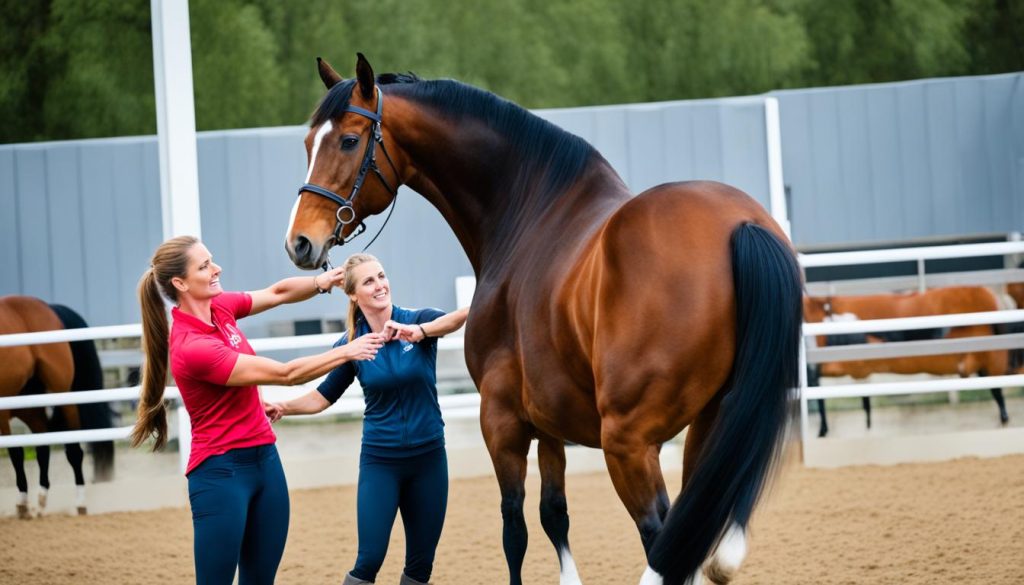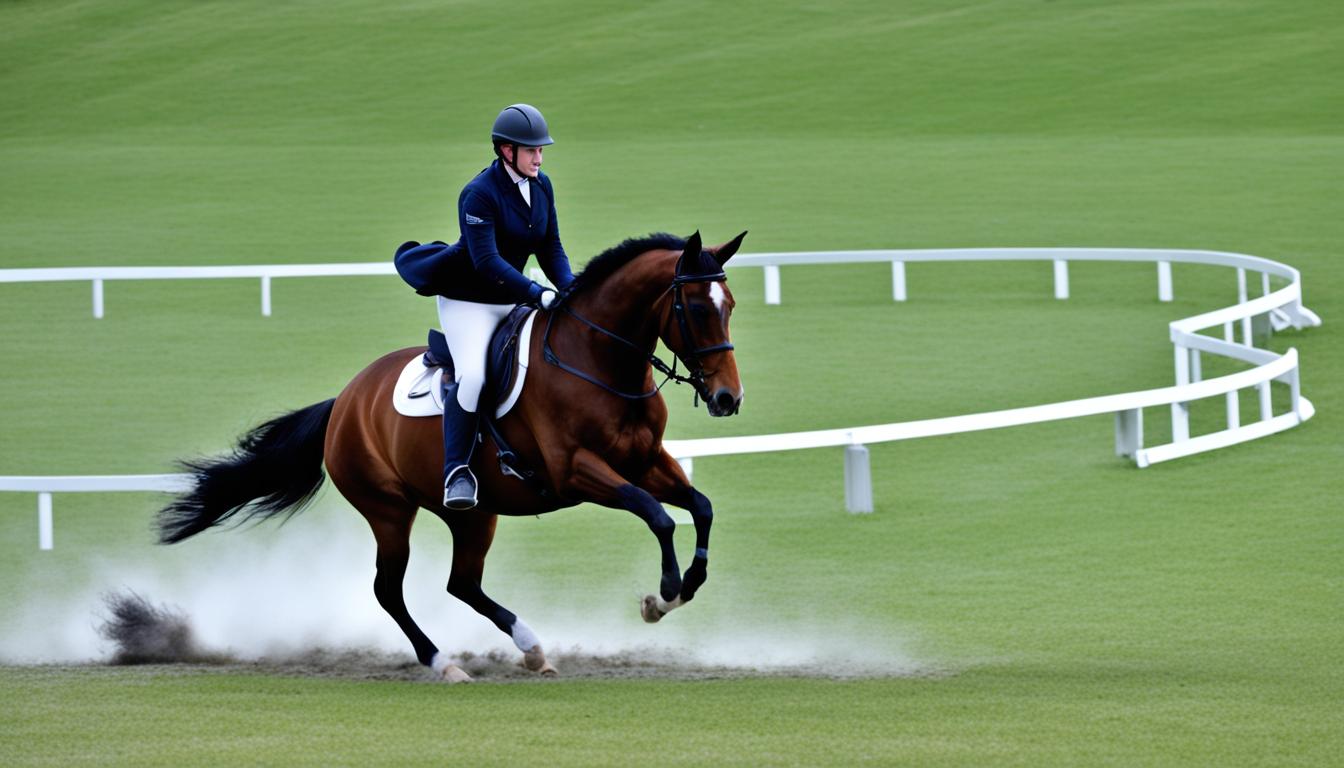“The essential joy of being with horses is that it brings us in contact with the rare elements of grace, beauty, spirit, and freedom.” – Sharon Ralls Lemon
Are you looking to deepen your bond with your horse and improve your horsemanship skills? If so, mastering basic liberty horse training commands is the key to unlocking a whole new level of connection and understanding between you and your equine partner. Liberty training allows horses to perform freely, without the use of tack or restrictions, while still remaining connected and responsive to their trainer.
In this article, we will explore the world of liberty horse training and discover the incredible benefits it offers for you and your horse. From building trust and enhancing groundwork skills to developing clear communication and mutual respect, liberty training is a powerful method that can be applied to horses of any age, breed, or discipline.
Through a combination of body language cues, vocal aids, and false aids, you will learn how to effectively communicate with your horse and guide their movements. By understanding the mindset of your horse and developing emotional regulation, you will create a calm and harmonious training environment that fosters growth and learning.
So, whether you’re a seasoned equestrian looking to expand your training repertoire or a beginner seeking a gentle and effective approach, basic liberty horse training commands will revolutionize your horsemanship journey. Get ready to witness the grace, beauty, spirit, and freedom that comes from partnering with these magnificent creatures.
Key Takeaways:
- Mastering basic liberty horse training commands deepens the bond and understanding between you and your horse.
- Liberty training offers benefits such as improved groundwork skills and enhanced communication.
- Effective communication in liberty training is achieved through body language cues, vocal aids, and false aids.
- Understanding the mindset of your horse and maintaining emotional regulation are key to successful liberty training.
- By incorporating liberty horse training into your horsemanship, you can experience the joy of grace, beauty, spirit, and freedom.
The Benefits of Liberty Horse Training
Liberty horse training offers numerous benefits that go beyond just enhancing the bond between you and your horse. Through this training approach, you can establish clear communication, build trust, and foster a positive relationship with your equine partner. By utilizing various horse training techniques, including positive reinforcement and establishing effective communication, you can achieve remarkable results. Let’s explore the advantages that liberty horse training brings:
Safe Handling and Responsiveness
One of the key benefits of liberty horse training is that it promotes safe handling. When horses are trained at liberty, they become responsive and cooperative, making it easier to maneuver and guide them without the use of tack or physical restraints. This builds a foundation of trust and respect between you and your horse, ensuring a safer and more enjoyable training experience.
Addressing Behavioral Issues and Building Confidence
Liberty training is a powerful tool for addressing behavioral issues and building confidence in horses, especially those who have experienced trauma or have behavioral challenges. By establishing positive reinforcement techniques and using empathetic training methods, you can help your horse overcome fear, anxiety, and other behavioral problems. This process allows the horse to regain confidence, develop trust in their human companion, and flourish in their training journey.
Teaching Clear Communication and Responsiveness to Lighter Aids
Liberty training focuses on fostering clear communication between you and your horse. Through this training approach, your horse learns to interpret your body language, vocal cues, and other non-verbal signals effectively. As a result, they become more responsive to lighter aids, allowing for subtle cues and commands. This level of responsiveness paves the way for teaching more complex movements and tasks in the future.
Freedom of Expression and Reduced Resistance
Liberty horse training provides a unique opportunity for your horse to express themselves freely without resistance or confusion. By allowing your horse the freedom to participate in their training without physical restrictions, you encourage them to explore their natural movements and behaviors. This approach creates a positive and harmonious learning environment that fosters trust, creativity, and a deeper connection between you and your equine companion.
“Liberty training unlocks the true potential of the horse-human bond, enabling communication based on trust, understanding, and mutual respect.”
– Name Surname, Liberty Horse Training Expert
Building a Stronger Partnership
When you engage in liberty horse training, you strengthen the partnership between you and your horse on multiple levels. This training approach deepens the emotional connection, establishes a solid foundation of trust, and enhances the overall understanding between you and your equine companion. Together, you can achieve incredible results, overcome challenges, and embark on a rewarding journey of growth and achievement.
With the benefits of liberty horse training, you can forge a deeper bond, establish effective communication, and unlock your horse’s true potential.
| Benefits of Liberty Horse Training |
|---|
| Safe handling and responsiveness |
| Addressing behavioral issues and building confidence |
| Teaching clear communication and responsiveness to lighter aids |
| Freedom of expression and reduced resistance |
| Building a stronger partnership |
As you can see from the table above, liberty horse training offers a comprehensive range of benefits that contribute to the overall well-being and performance of your horse. Embrace this approach, and witness the transformative power it has on your relationship with your equine partner.

The Aids in Liberty Horse Training
In liberty horse training, there are various aids that are used to communicate with the horse and guide their movements. These aids include body language cues, vocal aids, and false aids. Let’s take a closer look at each of these aids:
Body Language Cues for Horses
Body language cues play a vital role in liberty horse training. Horses are highly attuned to the subtlest movements and gestures of their trainers. By using your body language effectively, you can convey your intentions and communicate with your horse without the need for physical contact.
Here are some common body language cues used in liberty training:
- Stance and posture: Standing tall and facing the horse can signal direction and encourage movement.
- Eye contact: Maintaining eye contact can establish a connection and convey your focus.
- Gestures: Raising your arms, extending your hand, or pointing in a certain direction can indicate the desired movement.
- Energy and presence: Conscious control of your energy level and presence can influence the horse’s response.

Vocal Aids for Horses
Vocal aids are another essential part of liberty horse training. Horses are highly receptive to sound, and by using specific vocal cues, you can effectively communicate with your horse during training sessions.
Examples of vocal aids include:
- Verbal commands: Teach your horse specific verbal cues such as “walk,” “trot,” or “halt” to guide their movements.
- Whistles: Using different whistle patterns or tones can be a useful way to convey messages to your horse.
- Clicker training: This technique involves using a clicker, accompanied by a reward, to mark desired behaviors.
False Aids in Horse Training
False aids are tools or props that are used to aid in training but are not intended to cause discomfort or harm to the horse. These aids help to reinforce specific cues and enhance communication during liberty horse training sessions.
Examples of false aids used in liberty horse training include:
- The use of a whip: The whip can be used as an extension of your body to indicate direction or to emphasize a cue.
- Pole or target: These objects can be used to direct the horse’s movement or encourage them to focus on a specific task.
- Flags or ribbons: These visual aids can be used to attract the horse’s attention and guide their movements.
It is important to note that the use of false aids should always be done with care and understanding, ensuring the horse remains comfortable and responsive throughout the training process.
By incorporating these aids into your liberty horse training sessions, you can effectively communicate with your horse, guide their movements, and build a strong connection based on trust and understanding.
Developing the Human and Horse Mindset in Liberty Training
When working at liberty with a horse, it is essential to understand the differences in mindset between humans and horses. Horses are prey animals that think about multiple things at once to ensure their safety, while humans are hunters who focus on one thing at a time. This fundamental difference in mindset is crucial to consider when engaging in liberty horse training.
For horses, their survival instincts and awareness of their surroundings take precedence over single-pointed focus. In the wild, horses rely on their senses to detect potential threats and react accordingly. They must constantly assess their environment, the herd dynamics, and be ready to take flight at any moment. Developing an understanding of this instinctual behavior allows trainers to work with the natural inclinations of the horse and navigate the training process more effectively.
Conversely, humans possess a different mindset shaped by their role as predators. Training a horse often involves breaking tasks down into smaller, focused steps to achieve desired outcomes. This approach contrasts with the horse’s instinctual behavior, as it requires humans to concentrate on a single task rather than considering multiple factors simultaneously.
In the context of liberty training, humans must bridge this gap by opening up to the horse’s world and seeing things from their perspective. This means being able to comprehend the horse’s need for constant vigilance and understanding the importance of acknowledging their innate instincts. Empathy and emotional intelligence play a significant role in building a strong bond and connection between humans and horses in liberty horse training.
Emotional regulation and control also play a vital role in liberty training. Since horses are highly sensitive animals, it is paramount for the human to provide reassurance and maintain a calm training environment. By exhibiting a calm and assertive demeanor, the human can establish trust and create a safe space for the horse to explore and learn. Developing mutual trust and respect is the cornerstone of successful liberty horse training.
Understanding Horse Behavior in Liberty Training
In order to effectively engage in liberty training, it is essential to have a solid understanding of horse behavior. Horses communicate primarily through their body language, which includes subtle movements of their head, ears, tail, and posture. These visual cues convey a horse’s emotional state and intentions, allowing trainers to interpret and respond appropriately.
By observing and familiarizing themselves with horse behavior, trainers can better comprehend the horse’s responses to their cues and adjust their approach accordingly. This understanding enables trainers to recognize signs of stress, fear, or resistance and address them in a manner that fosters trust and cooperation. In liberty training, horses are given the freedom to express themselves without resistance or confusion, and trainers must be attuned to their behavior to ensure the training remains positive and effective.

| Horse Behavior | Description |
|---|---|
| Ears forward | Indicates attentiveness and engagement |
| Ears pinned back | Sign of aggression or irritation |
| Tail swishing | Can signify annoyance or discomfort |
| Swinging hindquarters | Indicates relaxation and trust |
| Head low, licking and chewing | Sign of relaxation and understanding |
“The more you understand your horse’s behavior, the better equipped you are to communicate effectively and build a strong partnership.” – Pat Parelli
Developing the human and horse mindset in liberty training requires patience, observation, and a willingness to adapt to the needs of each individual horse. By embracing the differences in mindset between humans and horses, trainers can create an environment that promotes understanding, trust, and effective communication. Through this collaborative approach, liberty horse training can foster a deep bond and forge a partnership based on mutual respect and cooperation.
Conclusion
Mastering basic liberty horse training commands is an essential aspect of building trust and establishing a strong bond with your horse. Through this training method, you can embrace the natural horsemanship techniques that allow your horse the freedom of movement and expression while maintaining a deep connection with you as their trainer.
By consistently practicing clear communication and incorporating effective horse training techniques, you can deepen the relationship with your horse and achieve incredible results in your training sessions. Liberty training for horses is a journey that requires patience, consistency, and understanding of the horse’s mindset.
Through liberty training, you can tap into the innate instincts and behaviors of your horse, allowing for a stronger foundation in your relationship. By honing your skills in basic liberty horse training commands, you are creating an open line of communication that fosters mutual trust and respect.
Start your journey in liberty horse training today and experience the transformative power it can have on your relationship with your horse. Embrace the freedom, establish a connection, and watch as your horse becomes responsive, confident, and willingly partners with you in achieving your horsemanship goals.
